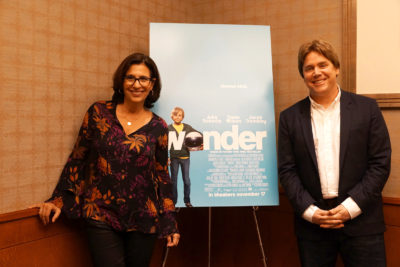
“Wonder,” a 2012 New York Times best-selling book by R.J. Palacio, is headed to the big screen in a film directed by Stephen Chbosky on Nov. 17.
In preparation for the release, both the author and the director discussed the process of filmmaking and the take-away from the story at The Ritz-Carlton Boston for a roundtable interview on Monday afternoon.
“I’ve often described [the book] as being a meditation on kindness,” Palacio said during the roundtable talk. “The theme of the book is the importance and the impact of kindness.”
Chbosky, who is also a critically-acclaimed author — most notably for “Perks of Being a Wallflower” — and Palacio described their collaboration in making the movie, building on their bond as authors and how that contributed in the authenticity of the storytelling.
“[Chbosky] wanted to be completely faithful to the book, faithful to the intent and the spirit of the book,” Palacio said. “I had faith he would do it.”
While the two joked and laughed about their disagreement of the song choice of “Santa Claus is Comin’ to Town” by Bruce Springsteen in the film, most of the plot proved to be the same in the film as the novel with minor changes.
With this mutual understanding of preserving the accuracy of the story’s central themes, Chbosky said he made it his mission to maintain the complex narrative built into the story by giving “perspective through narrative and quick shots,” he said.
“There’s something about shining a really simple light on a simple truth and let the audience make their own conclusions,” Chbosky said. In this way, he explained, he wanted the viewers to take the lessons and perspectives into their lives.
Palacio famously employed the use of imagination on the audience’s part in her novel in this way, specifically describing the extent of the main character’s craniofacial anomaly, which is a deformity in the growth of the head and facial bones, according to the Stanford Children’s Health website.
“It didn’t matter ultimately what he looked like, it’s just that he looked different. And the movie gets that,” Palacio said.
Chbosky described the careful prosthetics process for now-11-year-old Jacob Tremblay, who plays Auggie Pullman, and the precision of making the makeup realistic enough that it was still true to Tremblay’s performance.
“Jacob is a once-in-a-generation talent,” Chbosky said. “In order for the audience to respond to Auggie, it had to be the real Jacob.”
Both Palacio and Chbosky made emotion a huge part of the story, ensuring that audiences of all ages could find an eye-opening lesson from Auggie’s experience through fifth grade.
“One of the worst things a writer can do is write down to a certain age group. Certainly, I tried not ever to do that with ‘Wonder,’” Palacio said.
But she did admit that she kept her “target audience in mind” by keeping sentences shorter than usual.
Chbosky said he loved the book so much that he felt that if he focused on showcasing the characters, everyone of any age would connect with the story.
“Regardless of how you get into the story … I was hoping everyone would find the same exit,” Chbosky said. This same exit, he said, is the emphasis on kindness and empathy. Chbosky went on to describe how the actors of this age connected with the lesson greatly, and were “so kind.”
He’s such a fan of the story behind ‘Wonder’ that he said he ranks it with “To Kill a Mockingbird” and “The Outsiders” as “American literature that must be taught in the middle grade.”
“I don’t cast actors — I cast human beings,” Chbosky said, describing how he wanted the kids to bond and for the filming to feel more like a “summer camp than a job.”
This bonding and joy carries through the screen to the viewer of “Wonder.” Palacio enjoyed the feeling of the movie, noting that it is necessary in today’s society.
“You leave the movie feeling really good, and certainly given the times we’re living in now that’s really great,” she said.
This collaborative experience between the two authors, however, was not met without some change to the film adaptation. Yet, Palacio said she is happy with how the movie turned out, and no matter the difference in how she pictured Auggie versus how he was portrayed, she can only see Tremblay’s Auggie now.
For her, the film and the book go hand in hand serving the same goal of encouraging people to always “choose kind,” she said.
In agreement, Chbosky said he hopes “that the movie will lead everybody back to the book.”
No matter the difference in details, it is clear that one central theme is revisited throughout both adaptations.
“I tried to remind us all the time that we are not our conditions, we are ourselves,” Chbosky said.



